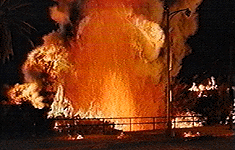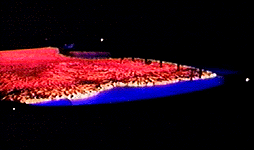Spotlight : May 1997
VFX Supervisor Mat Beck Goes With the Flow on VOLCANO
By Todd Vaziri
Spotlight : May 1997
VFX Supervisor Mat Beck Goes With the Flow on VOLCANO
By Todd Vaziri
Imagine the task of creating an erupting volcano right in the center of Los Angeles. Imagine being handed the duty of depicting hot, molten lava gushing down Wilshire Boulevard. Imagine the effort it would take to show an enormous skyscraper being demolished. All of these fantastic images were created for Twentieth Century Fox's monster hit, VOLCANO. The man who was handed these impossible sounding tasks was visual effects supervisor, Mat Beck.
Beck has previously worked on such features as James Cameron's effects-filled THE ABYSS and TRUE LIES, HERO and DEFENDING YOUR LIFE. With LightMatters Inc., he's created imagery for THE NUTTY PROFESSOR and STRANGE DAYS. Easily, VOLCANO would be his biggest challenge yet. 200+ shots later, VOLCANO is a rousing success.
"If the lava didn't look believable and scary, we would have been in big trouble. We knew it was an enormous task going into it." And they didn't have much time. The production of VOLCANO was quite hectic--Beck was brought on to the production a mere eight weeks prior to first unit photography. During that time, he and his crew embarked on a dual approach to the visual effects.
"I figured that the best way to proceed was in two different directions at once. We decided early on that we would take two approaches: we were going to try CG lava and we were going to try miniature lava." Beck supervised the two crews, working as quickly as possible under the strict time deadlines, to come up with the technique they would use to depict the lava in the film. "The idea always was to bring the two techniques together. We realized the strengths and weaknesses of each method, and in doing so, we were eventually able to seamlessly cut between CG and miniature shots in the movie."
CG lava was used for intense shots, such as a shot with a lot of camera movement, or one of the many helicopter shots. To make sure that the CG lava matched with the miniature lava, Beck explains, "we took textures from the miniature lava and used those to wrap around our CG lava elements."
More miniature work was done on VOLCANO than people believe. "We had done a lot of tests of shooting water into the air to create the lava geyser. "[VIFX visual effects supervisor] John Wash shot a lot of liquid up in the air, and the tests looked very promising." Eventually, the geyser shots were accomplished with miniature water geysers with heavy digital manipulations to make the water appear like molten lava, as well as adding all the appropriate reflections and shadows.
The notion that miniatures would become obsolete with the emergence of computer generated imagery is certainly smashed when one looks at the production of VOLCANO, where miniature elements were extensively used. "The reports concerning the death of the miniature business have been greatly exaggerated."
Beck remarks: "Imagine the scenario of creating a dust cloud for an effects shot. Think about it: there are billions and billions of particles doing their thing, all at once, all moving in different directions and at different velocities. Even at this point, a computer can choke on this many calculations. Then, consider the possibility of shooting a dust cloud for real as a miniature. It's real-time rendering!" Beck also adds to the debate of CG versus miniatures, "I'm not an old school guy or a new school guy. The way I handle visual effects techniques is to use whatever works. For our purposes, miniatures were an important part of creating the effects in VOLCANO."
Special Thanks to Scott Shields for his assistance.
 When Beck first read the script, and realized that the lava was going to be the villain in the film, he immediately began coming up with options for the production on how to create the visual effects. "Honestly, we didn't know how we were going to do it," Beck said. "The lava was the principal antagonist in the film--it was the bad guy! We knew we had to make it as credible and realistic as possible."
When Beck first read the script, and realized that the lava was going to be the villain in the film, he immediately began coming up with options for the production on how to create the visual effects. "Honestly, we didn't know how we were going to do it," Beck said. "The lava was the principal antagonist in the film--it was the bad guy! We knew we had to make it as credible and realistic as possible."
 For many Wilshire Blvd. sequences where the camera was close to the ground, the miniature lava was used. A thick mixture of goop was used on the 1/8 scale bluescreen set, where dummy objects were placed where cars and lamposts appear in the plate photography. The miniature lava looked and flowed like the real thing.
For many Wilshire Blvd. sequences where the camera was close to the ground, the miniature lava was used. A thick mixture of goop was used on the 1/8 scale bluescreen set, where dummy objects were placed where cars and lamposts appear in the plate photography. The miniature lava looked and flowed like the real thing.
 Miniatures were also used for the film's climactic ending of the movie. For the destruction of the skyscraper near the end of the film, a 1/10 scale miniature set was created by John Stirber Visual Network. The miniature skyscraper measured 35 feet tall, and its destruction was shot by by VOLCANO's effects cinematographer, David Drzewiecki.
Miniatures were also used for the film's climactic ending of the movie. For the destruction of the skyscraper near the end of the film, a 1/10 scale miniature set was created by John Stirber Visual Network. The miniature skyscraper measured 35 feet tall, and its destruction was shot by by VOLCANO's effects cinematographer, David Drzewiecki.
Links: VOLCANO
Back to the Spotlight Main Menu

. . VFX HQ Produced by Todd Vaziri . . http://www.vfxhq.com . . e-mail: tvaziri@gmail.com . .
All text Copyright © 1998 Todd Vaziri, unless otherwise noted